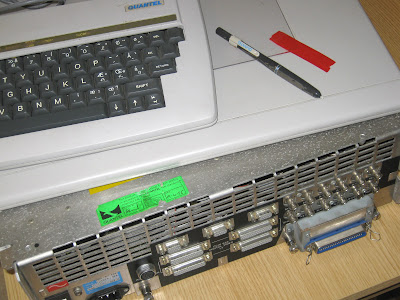The Quantel Paintbox was a set of custom hardware and software that revolutionised the video and TV production industry throughout the world in the 1980s and 1990s. Allowing easy and fast graphics to be produced for broadcast.
Developed by a UK company Quantel the Paintbox went through a number of revisions, the hardware was a custom design based on the Motorola 68000, most of the graphical features were realised in hardware.
I was offered one of the 2nd generation machines dating from 1989 codenamed 'Harriet'. Part of the V-Series of hardware the Harriet was a fully loaded system featuring optional hardware for 3D perspective shaping of graphics and video capture to a large internal RAM store called the Ramstore. Cost at the time of production was around £65,000.
The system is modular, in that there is a backplane which cards are plugged into. Exactly which boards are supplied with the base system and which are optional i am not sure yet. Certainly the main CPU board and video output boards would be standard, in the Harriet there are also the Perspective, Main Store, Main Store 2 and Video Input boards.
The system as i received it included the base unit, keyboard, tablet, pen & cables. Complete with the exception of the 'Rat' which was like a mouse.
My system is currently non-functional, the CPU board is fairly sophisticated however and has some diagnostic features and details the fault as a Bus Error.
The Harriet uses a Motorola 68010 CPU running at 10Mhz, there is a small amount of ROM which stores the bootloader and a CPU monitor, this bootstraps the main operating system from an internal 5.25" SCSI drive.
The Monitor application has a RS232 output port which has a menu and diagnostic features easily accessible with an appropriate terminal application on another computer.
Bus Errors on the 68000 CPU are monitored by external circuitry that asserts the BERR line on the CPU when no data returns on the bus when requested. A simple binary counter is used in the Paintbox clocked from the main oscillator. When the counter reaches a certain point one of the binary outputs asserts the BERR line through an inverter. As memory is accessed and data returned it continually resets the counter, unless there is a fault. When a BERR occurs the CPU jumps to the exception vector for the BERR and executes code there.
In part 2 i will detail more of my investigation...
